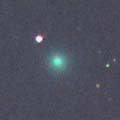
|
New comet discovered by many people in the SWAN images released in late August. It has already passed the perihelion on Aug. 9, and it is fading now. But it is still bright as 10.9 mag (Sept. 8, Seiichi Yoshida). Large and diffuse. In the Northern Hemisphere, it keeps low in the evening until early September, then it will be higher in the morning sky after mid September. But it will be 13 mag in October. In the Northern Hemisphere, it must have been visible in good condition in the evening before the discovery, however, it is unobservable after this.
Date(TT) R.A. (2000) Decl. Delta r Elong. m1 Best Time(A, h)
Sept.10 11 25.79 48 5.5 1.275 0.876 43 11.0 19:40 (141, 12)
Sept.17 11 20.55 51 45.0 1.284 0.992 49 11.5 4:19 (218, 16)
|

|
It will reach to 9 mag in 2006 spring. In the Southern Hemisphere, it keeps observable for a long time. In the Northern Hemisphere, it is not observable until 2006 March, except it appears very low in the morning at 12 mag from late August to early September. After 2006 March, northern people can observe it for a long time while it is getting fainter. It brightened up to 13.9 mag on Aug. 1 (Michael Mattiazzo). Now it must be bright as 11-12 mag already, and it locates high in the Southern Hemisphere, however, no observations were reported recently. So it may be fainter than expected.
Date(TT) R.A. (2000) Decl. Delta r Elong. m1 Best Time(A, h)
Sept.10 6 3.77 -42 28.0 2.424 2.528 84 11.5 4:12 (332, 5)
Sept.17 6 8.42 -47 4.1 2.310 2.464 86 11.2 4:19 (339, 3)
|

|
It was recorded as an asteroid at the discovery in 2002. It returned again now, and the faint tail was detected and it revealed to be a comet in fact. It passed very close by the earth in August, brightened rapidly from 15 mag to 12 mag. It had been too close to the sun for a while, but it is appearing in the morning sky again now. Very large and diffuse, but very bright as 11.5 mag (Sept. 7, Michael Jager). It is getting higher gradually after this. It will pass the perihelion on Sept. 17, so it will keep bright as 12-13 mag in September.
Date(TT) R.A. (2000) Decl. Delta r Elong. m1 Best Time(A, h)
Sept.10 9 10.97 12 13.0 0.517 0.624 31 11.9 4:12 (262, 11)
Sept.17 9 19.82 9 6.2 0.642 0.606 35 12.2 4:19 (268, 14)
|
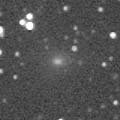
|
It kept bright as 11.5 mag since early August, and it is still bright as 11.5 mag (Sept. 3, Reinder J. Bouma). But it will be fading gradually after this. In the Northern Hemisphere, it keeps very low in the morning until mid October, with an altitude of around 10-15 degree. Then it will be higher gradually, however, it will be fainter than 14.5 mag when the altitude becomes higher than 30 degree. In the Northern Hemisphere, it is unobservable until December.
Date(TT) R.A. (2000) Decl. Delta r Elong. m1 Best Time(A, h)
Sept.10 10 34.45 41 13.8 1.796 1.167 37 11.9 4:12 (227, 12)
Sept.17 11 1.42 37 17.1 1.859 1.201 35 12.1 4:19 (231, 11)
|
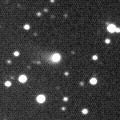
|
Although it was faint as 16.4 mag at the discovery in March (Mar. 12, R. H. McNaught), then it brightened well as expected, and now it is 11.4 mag (Sept. 8, Juan Jose Gonzalez). It is very small with a diameter of around 1 arcmin, and very strongly condensed. In the Southern Hemisphere, it keeps locating high until November while the comet is getting brighter gradually. In the Northern Hemisphere, it had kept locating very low around 15 degree high, but it will be getting higher slowly after this. However, it will be only 25 degree high at most from October to December. It will reach to 10 mag in early 2006.
Date(TT) R.A. (2000) Decl. Delta r Elong. m1 Best Time(A, h)
Sept.10 19 27.47 -36 58.5 2.014 2.658 119 12.2 20:09 ( 0, 18)
Sept.17 19 26.47 -36 0.3 2.026 2.590 113 12.1 19:40 ( 0, 19)
|
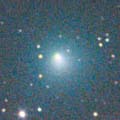
|
It kept bright as 10 mag from May to August, and it was still bright as 10.9 mag on Aug. 5 (Seiichi Yoshida). However, it has already started fading, and it faded down to 11.7 mag on Sept. 3 (Jose Carvajal). It is already very low in the evening in the Northern Hemisphere, and few observations have been reported recently. But it keeps observable in the Northern Hemisphere locating very low in the evening until December with an altitude of aroud 17 degree. In the Southern Hemisphere, it keeps locating high until November.
Date(TT) R.A. (2000) Decl. Delta r Elong. m1 Best Time(A, h)
Sept.10 16 31.66 -29 48.8 1.420 1.645 83 12.2 19:40 ( 32, 17)
Sept.17 16 53.12 -30 45.2 1.495 1.673 81 12.5 19:29 ( 31, 16)
|
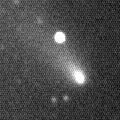
|
Although it became brightest about 2 weeks before the perihelion passage in its last appearance in 1998, it kept brightening until the perihelion passage in this return, and reached to 9.2 mag on July 2 (Carlos Labordena). After that, it faded down to 10.4 mag on Aug. 5 (Seiichi Yoshida). It must be already faint as 12 mag, but no observations were reported recently. It will be fading while locating around 30 degree high after this in the Northern Hesmisphere.
Date(TT) R.A. (2000) Decl. Delta r Elong. m1 Best Time(A, h)
Sept.10 7 24.31 -1 5.9 1.654 1.400 57 12.5 4:12 (290, 24)
Sept.17 7 39.72 -3 31.1 1.677 1.461 59 12.9 4:19 (295, 26)
|

|
In January when it was visible in the Northern Hemisphere, it was an 11 mag small object. However, after it has gone to the southern sky, it brightened rapidly and reached to 8.0 mag from March to April (Mar. 4 and Apr. 7, Alexandre Amorim). After the perihelion passage on Apr. 10, it turned to be fading slowly. It is bright as 12.3 mag still now (Sept. 3, Reinder J. Bouma). In the Northern Hesmisphere. It keeps observable in good condition while fading gradually. The split of the nucleus was found on June 25. Both nucleus can be detected on CCD images. No effect of the split was found on the total brightness of the comet.
Date(TT) R.A. (2000) Decl. Delta r Elong. m1 Best Time(A, h)
Sept.10 23 48.12 29 36.5 1.657 2.544 144 12.5 0:34 ( 0, 85)
Sept.17 23 29.30 29 47.0 1.724 2.630 147 12.8 23:41 ( 0, 85)
|

|
It was fantastic, so bright as 3.5 mag, so large as 30 arcmin, locating high overhead at its best time in early January. Then it has been getting fainter and smaller gradually, and 12.5 mag on Sept. 3 (Edwin van Dijk). The diameter is small now, about 2 arcmin, and very diffused. In the Northern Hemisphere, it keeps observable in good condition for a long time while the comet is bright enough visible visually until October when it becomes faint as 14 mag. Although it has been observable in the Northern Hemisphere for about one year since its discovery, now it is getting lower and lower. It will be lower than 20 degree at 13.5 mag in late September.
Date(TT) R.A. (2000) Decl. Delta r Elong. m1 Best Time(A, h)
Sept.10 14 33.34 12 13.0 3.874 3.316 49 13.1 19:40 ( 86, 26)
Sept.17 14 41.17 10 49.4 4.009 3.390 46 13.3 19:29 ( 87, 24)
|

|
In its last appearance in 1984, it unexpectedly brightened after the perihelion passage, and reached to the maximum brightness about 45 days after the perihelion passage. In this return, it was 11.3 mag around the perihelion passage (June 16, Juan Jose Gonzalez), but it continued brightening even after that, and reached to 10.2 mag on July 2 (Juan Jose Gonzalez). However, it turned to fade out 20 days after the perihelion passage in this time. The unexpected brightening in its last appearance seems to be an exceptional outburst. It already faded down to 12.6 mag on Sept. 3 (Reinder J. Bouma). It is getting lower in the evening gradually, and will be extremely low between October and November.
Date(TT) R.A. (2000) Decl. Delta r Elong. m1 Best Time(A, h)
Sept.10 13 23.64 41 59.9 2.197 1.680 46 13.2 19:40 (124, 27)
Sept.17 13 31.51 38 29.6 2.308 1.739 44 13.6 19:29 (121, 24)
|

|
It had been so faint as around 15 mag since May. It had been too faint to see visually. It was also invisible visually, fainter than 13.5 mag on Sept. 3 (Reinder J. Bouma). But an outburst occured on Sept. 9 and brightened to 13 mag (Stephane Garro). Now it is almost stellar.
Date(TT) R.A. (2000) Decl. Delta r Elong. m1 Best Time(A, h)
Sept.10 2 19.87 24 59.8 5.113 5.759 125 13.2 3:04 ( 0, 80)
Sept.17 2 18.29 25 4.3 5.032 5.760 132 13.2 2:35 ( 0, 80)
|
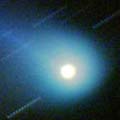
|
The brightness evolution had been slower than a typical comet since its discovery until the perihelion passage in early April. Although it had been observable only until March in the Northern Hemisphere, it has been observed continuously in the Southern Hemisphere, and it kept bright as 8 mag from mid March to mid May. It had been low until early July even in the Southern Hemisphere. The comet has faded out rapidly while locating low. No observations have been reported since mid May. However, it was observed on Aug. 1, when it was still bright as expected, 13.0 mag (Michael Mattiazzo). It is not observable in the Northern Hemisphere until late September when it appears very low sky at dawn as 14 mag.
Date(TT) R.A. (2000) Decl. Delta r Elong. m1 Best Time(A, h)
Sept.10 7 33.73 -37 9.6 2.883 2.643 66 13.3 4:12 (316, -2)
Sept.17 7 35.82 -38 7.2 2.924 2.729 68 13.4 4:19 (321, 2)
|
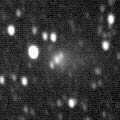
|
It kept bright as 12 mag from June to August, and it was still bright as 12.2 mag on Aug. 2 (Juan Jose Gonzalez), however, it faded down to 13.0 mag on Sept. 8 (Seiichi Yoshida). It had been very low in the Northern Hemisphere. Although it will be higher slowly after this, it is fading.
Date(TT) R.A. (2000) Decl. Delta r Elong. m1 Best Time(A, h)
Sept.10 18 5.35 -25 4.9 1.052 1.621 103 13.3 19:40 ( 13, 29)
Sept.17 18 23.31 -23 58.9 1.115 1.639 101 13.5 19:29 ( 13, 30)
|

|
It was bright as 7.5 mag in early January, easy to see with binoculars. However, it faded and got diffused rapidly in the evening sky after that. It faded to 10.7 mag on Mar. 15 visually (Alexandre Amorim), and 11.5 mag on Apr. 4 by CCD observation (Mitsunori Tsumura), then it became unobservable. The fading after the perihelion passage is slow. It is visible visually still now, bright as 12.3 mag (Sept. 3, Juan Jose Gonzalez). Because it is distant from the sun, it can be visible visually as 12-13 mag for a while.
Date(TT) R.A. (2000) Decl. Delta r Elong. m1 Best Time(A, h)
Sept.10 4 22.15 -7 57.5 4.127 4.468 103 13.4 4:12 (341, 45)
Sept.17 4 17.64 -8 37.9 4.091 4.539 110 13.4 4:19 (354, 46)
|
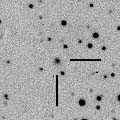
|
It brightened from 18 to 15 mag during one year from the end of 2003 to early 2005. The brightness evolution was much faster than that of a typical comet. After that, it kept 15-15.5 mag until May. Although it had been too low for a while, it is getting higher again now. It can be 13 mag and may be visible visually in next winter.
Date(TT) R.A. (2000) Decl. Delta r Elong. m1 Best Time(A, h)
Sept.10 8 48.40 44 47.8 6.013 5.433 50 14.5 4:12 (234, 30)
Sept.17 8 56.99 44 48.7 5.926 5.418 55 14.4 4:19 (236, 35)
|
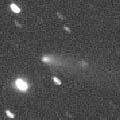
|
It was 16.8 mag at the discovery in May (May 20, R. H. McNaught). Then it brightened rapidly, and reached to 14 mag now (Aug. 2, Michael Jager). It is also visible visually as 13.7 mag (Sept. 3, Edwin van Dijk). Because it moves in the northern sky, it keeps locating high for a long time in the Northern Hemisphere. It will be visible visually at 14 mag until November.
Date(TT) R.A. (2000) Decl. Delta r Elong. m1 Best Time(A, h)
Sept.10 4 7.74 35 5.4 1.001 1.542 100 14.5 4:12 (267, 82)
Sept.17 4 21.25 37 42.3 0.978 1.559 103 14.5 4:19 (234, 85)
|
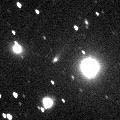
|
Although the CCD nuclear magnitude was reported so faint as 16.5-17 mag, it is actually bright as 15.7 mag (June 26, Giovanni Sostero). Sharply and strongly condensed with a narrow long tail. It will be 15 mag both in 2005 summer and 2006 summer. It moves southwards, so the condition in the Northern Hemisphere is better in 2005. It was visible visually as 13.8 mag (July 28, Seiichi Yoshida).
Date(TT) R.A. (2000) Decl. Delta r Elong. m1 Best Time(A, h)
Sept.10 16 37.57 34 43.9 3.794 3.749 79 15.1 19:40 ( 99, 61)
Sept.17 16 42.04 32 7.4 3.837 3.739 76 15.1 19:29 ( 96, 58)
|

|
Although it was faint as 16.4 mag in January, it brightened to 14.6 mag in May when it became at opposition (Jan. 26 and May 31, Ken-ichi Kadota). It was also visible visually as 14.3 mag (May 7, Juan Jose Gonzalez). Then it was predicted to be slightly fainter, however, it brightened furthermore visually, 13.8 mag on July 10 (Reinder J. Bouma). But on the other hand, the CCD nuclear magnitude became reported fainter, 15.5 mag in July. It is already low in the evening, and will be unobservable soon. It will be observable again as 15 mag in 2006 summer, then it will fade out.
Date(TT) R.A. (2000) Decl. Delta r Elong. m1 Best Time(A, h)
Sept.10 15 57.26 -23 37.8 3.185 3.078 74 15.3 19:40 ( 43, 17)
Sept.17 16 5.41 -24 6.5 3.269 3.073 69 15.3 19:29 ( 44, 16)
|

|
Recovery of a peculiar asteroid 2004 FS101 discovered in 2004 spring. Although it was 18 mag in mid January, it brightened to 16-16.5 mag in mid May. The brightness evolution was rather faster than that of a typical comet. It will be 14.5 mag around 2006 January, although it will be rather low for the northern observers. It keeps observable at 15-16 mag for a long time from 2005 spring to the end of 2006. Because it moves in the northern sky, it keeps observable for a long time in the Northern Hemisphere. It was not visible visually, fainter than 14.0 mag on Aug. 5 (Seiichi Yoshida).
Date(TT) R.A. (2000) Decl. Delta r Elong. m1 Best Time(A, h)
Sept.10 13 53.99 46 54.1 4.069 3.576 54 15.6 19:40 (127, 34)
Sept.17 14 3.23 46 46.6 4.036 3.547 54 15.5 19:29 (127, 32)
|

|
Although it was so faint as 17.5 mag in early May, it brightened rapidly in June while approaching to the earth down to 0.1 AU, and became visible visually as bright as 10.3 mag on June 25 (Juan Jose Gonzalez). Because it was so close to the earth, it had a very large and faint coma with a diameter of 4-8 arcmin. Surprisingly, it was detected on survey images on June 24 as a very bright and large object, 8-9 mag with a diameter of 20 arcmin (Terry Lovejoy). When it appeared again in the morning sky on Aug. 5, it was still visible visually, bright as 10.5 mag, but extremely diffuse (Seiichi Yoshida). Then it is fading out rapidly as expected, 12.5 mag on Aug. 14, and 14 mag on Sept. 1 (Michael Jager).
Date(TT) R.A. (2000) Decl. Delta r Elong. m1 Best Time(A, h)
Sept.10 5 59.43 13 58.1 0.617 1.062 77 15.6 4:12 (292, 50)
Sept.17 6 4.44 14 11.8 0.644 1.127 83 16.2 4:19 (299, 56)
|
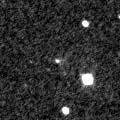
|
It was observed as 17.0 mag on July 10, as bright as expected. It will be 15.5 mag from September to December. IIt was 15.7 mag on Aug. 5, brighter than this ephemeris (Yuji Ohshima).
Date(TT) R.A. (2000) Decl. Delta r Elong. m1 Best Time(A, h)
Sept.10 0 29.89 -3 29.2 1.548 2.521 160 15.8 1:15 ( 0, 52)
Sept.17 0 27.35 -4 5.9 1.509 2.500 167 15.7 0:45 ( 0, 51)
|
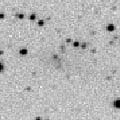
|
It was 13.6 mag on May 12, as bright as expected (Michael Mattiazzo). Although it is already high enough to observe, only few observations have been reported recently. It will be fading after this.
Date(TT) R.A. (2000) Decl. Delta r Elong. m1 Best Time(A, h)
Sept.10 5 14.31 11 5.8 2.199 2.400 88 15.8 4:12 (308, 56)
Sept.17 5 19.00 10 52.7 2.152 2.443 94 15.8 4:19 (319, 60)
|
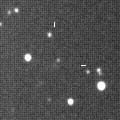
|
It will be 16 mag locating high in October and November. But it will be fainter than 18 mag at the end of 2005. It was 17.0 mag on Aug. 1, bright as expected (Michael Mattiazzo).
Date(TT) R.A. (2000) Decl. Delta r Elong. m1 Best Time(A, h)
Sept.10 21 30.32 -37 9.7 0.630 1.544 140 16.4 22:11 ( 0, 18)
Sept.17 21 23.48 -33 12.9 0.624 1.517 135 16.3 21:37 ( 0, 22)
|
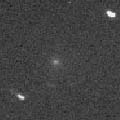
|
It was reported as 16.4 mag on Aug. 5 (Yuji Ohshima), brighter than this ephemeris. It will be observable at 16.5 mag in good condition until October.
Date(TT) R.A. (2000) Decl. Delta r Elong. m1 Best Time(A, h)
Sept.10 3 26.25 -6 44.3 0.920 1.645 117 16.5 4:10 ( 0, 48)
Sept.17 3 38.38 -8 59.7 0.912 1.661 120 16.5 3:55 ( 0, 46)
|

|
It brightened from 19 to 17 mag during a half of a year from summer to winter in 2004. The brightness evolution was rather faster than that of a typical comet. It had been very low for a while, but now it is getting higher again. It will be observable in good condition as 16 mag for a long time until next spring.
Date(TT) R.A. (2000) Decl. Delta r Elong. m1 Best Time(A, h)
Sept.10 8 48.70 52 5.0 5.613 5.114 55 16.7 4:12 (226, 33)
Sept.17 8 59.62 52 22.1 5.531 5.101 59 16.6 4:19 (227, 36)
|

|
Fading slowly. It will be fainter than 12 mag. It keeps locating high.
Date(TT) R.A. (2000) Decl. Delta r Elong. m1 Best Time(A, h)
Sept.10 1 36.68 64 22.2 5.602 5.954 105 17.3 2:21 (180, 61)
Sept.17 1 27.89 64 20.2 5.594 6.018 110 17.3 1:45 (180, 61)
|

|
First return of a new periodic comet. It keeps 17.5 mag until December. Although it had been low, it will be higher after this. So it will be recovered soon.
Date(TT) R.A. (2000) Decl. Delta r Elong. m1 Best Time(A, h)
Sept.10 8 1.48 17 39.3 2.224 1.731 48 17.3 4:12 (267, 28)
Sept.17 8 20.21 17 43.9 2.182 1.734 50 17.3 4:19 (269, 31)
|

|
It reached to 17 mag in 2004 autumn. Now it is getting higher again in the morning sky. It will be observable as 17 mag in good condition in winter again.
Date(TT) R.A. (2000) Decl. Delta r Elong. m1 Best Time(A, h)
Sept.10 7 3.44 20 43.2 3.431 3.098 62 17.5 4:12 (272, 41)
Sept.17 7 11.99 20 19.7 3.352 3.105 67 17.5 4:19 (277, 46)
|
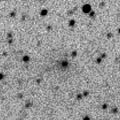
|
It will be at opposition again between autumn and winter, and observable at 17.5 mag locating high.
Date(TT) R.A. (2000) Decl. Delta r Elong. m1 Best Time(A, h)
Sept.10 4 17.33 18 14.8 4.100 4.415 101 17.6 4:12 (324, 70)
Sept.17 4 17.99 18 19.1 4.007 4.426 108 17.6 4:19 (347, 73)
|
|
![]()
 C/2001 Q4 ( NEAT )
C/2001 Q4 ( NEAT ) P/1998 W1 ( Spahr )
P/1998 W1 ( Spahr ) 119P/Parker-Hartley
119P/Parker-Hartley 65P/Gunn
65P/Gunn![]()

























